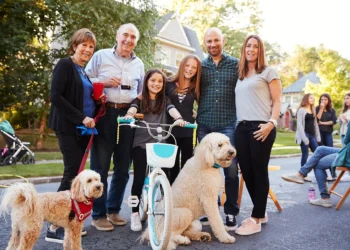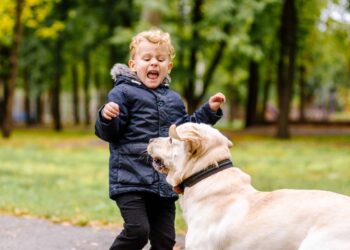Your dog must be your closest furry companion. Most pet dogs enjoy the company of family members, play with the other dogs in your home or neighborhood and stay calm. However, many dog owners experience their dog’s aggression when on a dog leash.
Your dog may begin barking, lunging around other dogs, other pets and animals it encounters, other people, or even at vehicles passing by. This awkward behavior of your dog is embarrassing for you as the owner. Again, it may be dangerous for the other dogs and people around you.
Is this some behavioral issue found in dogs? Are there any training methods to control this behavior? Let us reveal various aspects of this issue to teach your dog manners to prevent leash aggression when it is a puppy.
What is Leash Aggression in Dogs?
The tendency among pet dogs to turn aggressive when on a dog leash is known as leash aggression. Your dog shows normal behavior when at home and in the dog park around other dogs. It may also be playful and happy when along with your family members, neighbors, and other pets. However, as it is on a dog leash, dog owners experience sudden aggression among dogs.
Leash aggressive dogs may not enjoy the walk and turn it into a horrible encounter. The dog’s aggressive and reactive behavior turns unacceptable when you casually walk the dog or try to play with it while keeping it on the dog leash. The dog’s behavior may go out of control in most of these incidents.
What could be the Causes of Leash Aggression in a Dog?
Determining the root causes of leash aggression in dogs is a bit challenging. There may be several factors triggering aggressive leash behavior among dogs. To know more about behavioral issues among dogs, go through this blog.
Let us discuss some significant causes that you should know being a pet owner:
Not Socializing Dogs At The Right Age
Ideally, at the age of 8 to 14 weeks, a part of any dog’s brain processing the emotion of fear develops. It will help if you start socializing your puppy with other animals and people at this age. If a puppy does not get the required exposure to other dogs, pets, and people at this age, it may develop fear and aggression.

Overexcitement and Excessive Energy Levels
A dog may start barking lunging at another dog or a pet due to overexcitement. The reactive behavior while on the dog leash may result from the dog’s excessive energy that drains in this weird manner.
Bitter Experiences of the Past
Did other aggressive dogs in the past hurt your dog? If yes, it may decide to keep other dogs away. So, your dog lunges at other dogs during the walks. It may lunge at other pets in the surrounding area as well.
A Reaction
The tendency of your dog to lunge at the other dog may be a response to the other dog’s attack. In a dog park, there may be several leash reactive dogs. Proper leash training is essential to avoid this.
Excessive Leash Tension
Sometimes, a dog may turn aggressive at another dog because of mishandling and excess pull by the owner. If you add too much tension on the dog through the leash, your dog may be uncomfortable. This discomfort may trigger aggression.

Improper Advice
Some dog trainers and online training videos may mislead you. The tactics and gadgets you implement, such as a voice command through an e-collar, may turn your dogs on. This may be a significant cause behind the lunge and barks of your dog as it has eye contact with another dog.
Boredom
Sometimes, if your dog is bored, undertrained, or less exercised, your dog’s lunging at other dogs and pets may be an outlet to drain its boredom. Yet, this unacceptable behavior turns your walks into nightmares. Hiring a professional dog trainer to teach your dog some exercises, obedience, and responses to voice commands is crucial.
Poor Quality of Diet
To retain your puppy or dog energetic yet playful, calm yet active, you need to ensure that the diet you provide is balanced and nutritious. Your dog food and treats may need some corrections to avoid fear and aggression among your dogs. Dogs with poor gut bacteria may be more leash reactive, impulsive, and show similar behaviors.
Genetic Issues
Illness of a pregnant dog or fear in its grandparents may lead to leash aggression among dogs up to a considerable extent. Again, studies indicate that some dog breeds are more prone to leash aggression.
These are some significant causes of leash reactivity in dogs.
How To Prevent Your Dog From Being Leash Reactive?
Prevention is better than cure. Thus, you need to implement practical dog training before your dog gets leash reactive. If you have missed it out, there are proven training methods to control leash aggression in your dogs.
The following are some of the proven dog training techniques to prevent such aggressive behaviors among your dogs when on a dog leash:
Start with Dog Training Early
It is always easy to train a puppy. If you are intentional in avoiding possible leash reactivity, it is better to start early. The best way is to include the possible stimulus elements that lead to leash reactivity in your training. Take your puppy out to the world and teach it how to react to another dog, cat, squirrel, other pets, people around you, and vehicles.
Eliminate Chances of Health Issues
Are you sure that your dog is totally healthy? Sometimes, underlying medical conditions or pain may cause some abnormal behaviors, including leash aggression. You need to be a bit more conscious about the health issues of your puppy or dog. As the first step, consult a professional veterinarian regularly for health checkups and dental cleanups.
Positive Reinforcement
Let your puppy or dog realize that it makes you happy if they act normal with another dog. Reward your puppy or dog with treats as it displays good behaviors while around other dogs. Yet, make sure that another dog involved in your training is fully vaccinated.
Positive reinforcement is a part of training that helps you develop a better emotional bond with your puppy or dog. Therefore, it is wise if you keep some smaller, chewable, and easy-to-gulp training treats handy while walking with your furry friend.
Chances for Disposal of Energy
Leash aggression among high-energy puppies and dogs may be challenging to handle. Your puppy needs some points to dispose of the excess energy. So, you can let it run around in the dog park before bringing it on the dog leash. This could be a sensible way to prevent or treat leash aggression among hyperactive puppies and dogs.

Use Proper Dog Training Gear
To avoid excessive pulling between your shoulders and your dog’s neck, you can use a head halter. Use a dog leash with a bungee and a control loop. This helps in bringing your dog closer whenever needed. Such training gear proves helpful in controlling aggression leash to a greater extent.
Keep Your Dog Happy and Playful
If you want your dog to be playful with its friends in the dog park or your neighborhood, you should ensure that it is always happy and relaxed. Teach your dog to greet the other dogs by playing along with it and the other dogs around.
This may be a time-consuming process. Yet, regular playtime, exercise, a healthy diet, and socialization help your pup or dog stay away from behaviors like anxiety, stress, and aggression.
Reading Suggestion: 5 Ways To Show Your Dog Love That They Can Understand
Support Your Pup To Overcome Aggression
As a pet owner, when you find some triggers on your walking path, you can change the route or timings for your walks. Maintain a safe distance when your dog walks with another dog to avoid eye contact triggering reactive behavior.
Counter-conditioning
To control leash aggression in your dog, find the areas where there would be other dogs. As another dog would be in the sight of your dog, it starts pulling the leash. When it is about to bark, throw some treats in its view. Make it an encouraging game for your dog. Thus, let your dog understand the reward. It should know that you like it keeping calm when another dog is in sight. For this, it earns its favorite food or treats.
Find A Vet or Pet Behaviorist Near You
Is your dog afraid of other dogs or frightening the other dogs, pets, and people around? It is better to seek professional advice. You can get in touch with a nearby veterinary practice, a board-certified pet behaviorist, or a certified dog trainer to address this issue.
You can find the best-rated professional vets and pet behaviorists in your area through a reputed online vet database. You can search for a vet near you, see their profile, and schedule an appointment conveniently through any browser-enabled device. This method saves you valuable time and energy and helps you connect with the best veterinarians.
The Bottom Line
The article discusses the causes that make your dog leash reactive, dog training, and other methods to control leash aggression in dogs. We hope that you understand this behavioral issue better. We intend to encourage you to take the necessary steps at the earliest to train your dogs to minimize leash aggression.








